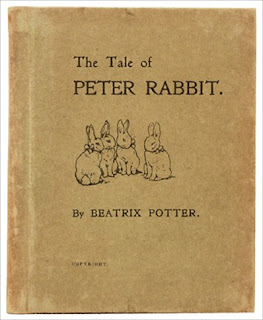I have been asked in the past, although not often, Why are there 3 first editions of Peter Rabbit? How can that be?
The answer is that there aren't really. There can be only one true first, but there can be variations in the text and then commercially produced editions, each of which lays a claim to that title.
With Peter Rabbit this is the case. There are three different books that are all refered to as First Edition, although qualified with the necessary publishing details as well, so we have;
1. First edition, 1st printing, a privately printed Edition. 250 copies.
2. First Edition, 2nd printing. A privately printed edition with minor corrections in the text. 200 copies.
3. First Published Edition. A commercially produced edition by a book publishing company. 8000 copies.
The story of Peter Rabbit is fairly well established. Potter, a keen naturalist and accomplished artist, had often written, and illustrated, short stories in letters to children of friends. On september 4th, 1893 Potter wrote such a letter to Noel Moore, the son of her former Governess, Annie Moore, who was unwell. This letter contained the story of Peter Rabbit.
A few years later, Potter come to the idea that the story would be of interest to other children and would make a nice book. Luckily, Moore had kept his letters from Beatrix and when she wrote to ask if she might borrow it, he returned the short Tale of Peter Rabbit.
The story was re-written in a school excercise book and a watercolour frontis and 42 line illustrations, prepared in pen and ink, were added, some based on the orignal drawings in that letter. Initially the story was titled "The Tale of Peter Rabbit and Mr. McGregor's Garden By H. B. Potter".
This manuscript was sent to several publishers during 1900 by Canon Hardwicke Rawnsley, a Family friend who was keen to help this new enterprise. All returned it without any interest.
In 1901 Potter had the manuscript privately printed by Strangeways and Sons of London in an edition of 250 copies. This little book, now re-named simply " The Tale of Peter Rabbit", made small enough for young children to hold and printed on durable paper, was issued, undated, on December 16th 1901, with the colour frontis and 41 of Potter's line drawings, in a plain grey/green paper covered binding with a flat spine, printed with a black line illustration and lettering to the front board.
1901. 1st printing.
Potter not only gave many copies to friends and relations, she also sold several at the very reasonable price of 1s2d. Unsurprisingly the book was a great success form the start and within a couple of weeks it was decided to have another edition, this time of just 200 copies, printed at the Author's expense, but this time in a better quality binding, with a rounded spine.
1902. 2nd printing.
This new printing allowed for a few minor changes to the text and the punctuation, and it was decided to print the publication date on the title page. This second printing was issued in February 1902.
1902. 2nd printing.
While Potter was producing her own editions of Peter Rabbit, She and Canon Rawnsley had been in negotiations with the Publisher Frederick Warne & Co, who had seen some potential in the story and its charming illustrations. This probably explains the decision to print fewer copies of the second printing, despite the huge success of the first. After much discussion about the cost of colour printing and how much should be charged for the book it was agreed that Warne's would publish the story, with slightly edited text, and just 31 (including the frontispiece) of Potter's illustrations reproduced in full colour from her watercolours.
This version, the first commercially published printing, was issued in October 1902 in an edtion of 8000 copies. This lovely little book, often called the First Trade Edition, was bound in either grey or brown boards with a colour illustration of Peter in his light blue jacket mounted to the front board with white lettering above and below and to the spine.
1902. First Trade editon.
A further 12000 copies were printed in November, and 8220 copies in December 1902. These 3 printings are identical internally. The only variation that exists is that some copies of the 2nd and 3rd printings were issued in green boards.
Despite the large number of books produced, copies in collectable condition are not common and are much in demand. This has led to many collectors willing to pay a premium for the best copies, while restored, worn and damaged copies sell for considerably less. This is the way the rare book market has been going for a number of years now with the difference in prices achieved for the very best and the run-of-the -mill copies growing ever wider.
Peter Rabbit's enduring success is partly down to Beatrix Potter's simple good story telling, partly her exquisite drawings, which she later water-coloured, and also her determination and good business sense. Truly a remarkable Woman and a great example of the Victorian "Can Do" attitude.




No comments:
Post a Comment